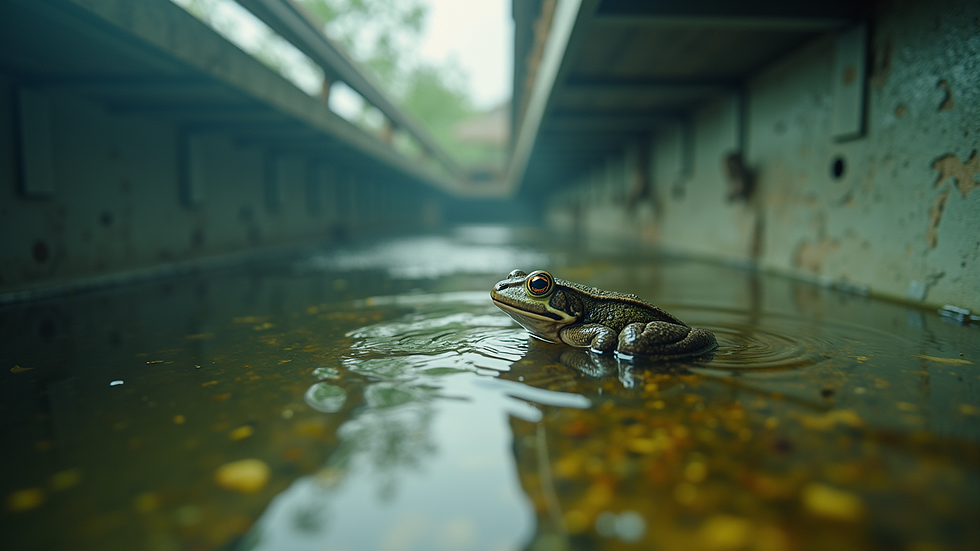Exploring the Role of Heated Refuges in Protecting Michigan Amphibians from Chytrid Fungus
- Joel Scoby

- Aug 22
- 3 min read
Amphibians are essential to our ecosystems. They indicate environmental health and play vital roles in food webs. Sadly, in Michigan, these fascinating creatures face a significant threat from a harmful pathogen known as chytrid fungus. This blog post explores the innovative use of heated refuges to protect local amphibian populations from this devastating disease.
Understanding Chytrid Fungus
Chytrid fungus, scientifically called Batrachochytrium dendrobatidis, is a waterborne pathogen that has caused significant declines in amphibian populations globally. It infects the skin of amphibians, making it hard for them to absorb water and electrolytes, which can lead to death. In Michigan, species like the Northern Leopard Frog and Eastern Tiger Salamander are particularly affected.
A troubling statistic reveals that in some regions, populations of certain amphibian species have decreased by over 80% due to this fungus. The spread of chytrid fungus worsens with environmental factors like temperature and moisture levels. As climate change disrupts these conditions, amphibians face increasing risks. This has led researchers and conservationists to find creative solutions to protect these species.
The Concept of Heated Refuges
Heated refuges are special areas that provide a warm microclimate for amphibians, helping them escape cold temperatures that can worsen the effects of chytrid fungus. These refuges can be created using materials such as heated rocks or artificial structures that retain warmth. The goal is to offer a safe haven where amphibians can thrive despite environmental challenges.
Benefits of Heated Refuges
Temperature Regulation: Heated refuges maintain stable temperatures that are less favorable for the growth of chytrid fungus. A research study found that temperatures at these refuges typically remained 5-10 degrees warmer than surrounding areas, improving amphibian health.
Increased Survival Rates: Findings indicate that amphibians utilizing heated refuges show survival rates nearly 30% higher than those in unheated environments. This is particularly crucial during vital life stages like breeding and metamorphosis.
Habitat Restoration: Implementing heated refuges contributes to habitat restoration. By creating environments that support amphibians, conservationists can help restore species that have been impacted by chytrid fungus and other environmental stressors.

Implementing Heated Refuges in Michigan
In Michigan, various conservation organizations and researchers are working together to implement heated refuges for local amphibians. These initiatives rely on planning and collaboration with communities to ensure project success.
Site Selection
Finding the right location for heated refuges is crucial. Ideal sites are often near existing amphibian habitats like wetlands or ponds, where amphibians breed and thrive. These areas with natural sunlight can help maintain the warmth needed for effective refuges.
Community Involvement
Engaging local communities is key to the success of heated refuge projects. Simple educational programs can raise awareness about the importance of amphibian conservation and how heated refuges help. When community members get involved, they feel a sense of ownership and are more likely to assist in monitoring and maintaining these refuges.

Monitoring and Research
Monitoring and research are essential components of the heated refuge initiative. Researchers use different methods to assess the effectiveness of these refuges in protecting amphibians from chytrid fungus. This includes tracking amphibian health, survival rates, and population changes over time.
Data Collection
Collecting data involves field surveys, temperature checks, and health assessments of amphibians using the refuges. This information is vital for understanding the long-term effects of heated refuges, enabling adjustments to conservation strategies.
Adaptive Management
As new data emerges, conservationists can adapt their management approaches to enhance the effectiveness of heated refuges. This flexibility ensures that efforts remain relevant and responsive to the needs of amphibian populations in Michigan.
A Path Forward for Amphibians
Using heated refuges offers a promising strategy for protecting Michigan's amphibians from the severe effects of chytrid fungus. These warm microclimates can improve survival rates and support population recovery.
As climate change poses ongoing challenges for amphibians, creative solutions like heated refuges become increasingly important. By fostering collaboration, involving communities, and conducting ongoing research, we can work together to secure a brighter future for Michigan's amphibians.




Comments